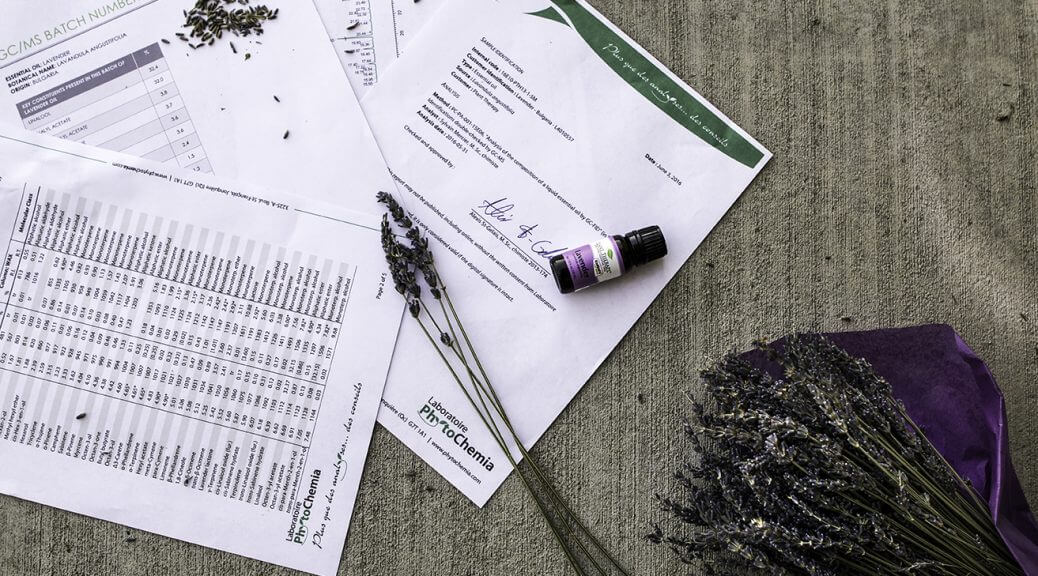Here at Plant Therapy each and every one of our batches of oil are GC-MS tested for quality and purity. These batch specific GC-MS reports are available right on our website for the convenience of our customers. Often times we are asked what a GC-MS test is, why it is so important, and how to read the tests. These are important questions and today we are happy to address them for you.
What is a GC-MS test?
Before we can discuss why GC-MS testing is so important we must first determine what a GC-MS test is. In a recent discussion with Alexis St-Gelais, one of the chemists we work with from Laboratoire PhytoChemia, he defined GC-MS testing when applied to essential oils as “an analytical chemistry technique allowing for separation, identification and partial quantitation of individual volatile molecules present in an essential oil. The technique thus allows to fingerprint the essential oil sample, whose profile can then be compared with reference profiles and screened for contaminants or adulterants.” [1]
A GC-MS test is completed using two separate techniques, GC or Gas Chromatography, and MS or Mass Spectrometry. To really know what GC-MS is we must discuss the separate parts and what takes place in the process. “The GC separates the chemical mixture into pulses of pure chemicals based on volatility or ease with which they evaporate into gas. Similar to a running race where a group of people begin at the starting line but as the race proceeds the runners separate based on their speed. The chemicals in the mixture separate based on their volatility. In general small molecules travel more quickly than larger molecules.” [2]
“The MS identifies and quantifies the chemicals based on structure. Let’s say after completing a puzzle you accidentally drop it on the floor. Some parts of the puzzle remain attached together and some individual pieces break off completely. By looking at these various pieces you are still able to get an idea of what the original puzzle looked like. This is very similar to the way the mass spectrometer works.” [2]
Why is GC-MS Testing Important?
Now that we know what a GC-MS test is and how it works let’s discuss why it is so important when it comes to essential oils. As Alexis mentioned this test allows us to fingerprint each sample showing us the unique identity of the essential oil. These tests are very important from a quality standpoint as it shows us the oils chemical makeup. Most contaminants or adulterants show up with these tests, and for those that don’t, if we suspect that some of what looks like a natural constituent of an oil might be a synthetic addition, we use chiral analysis – a more sophisticated form of gas chromatography – to find out if it is in fact, a natural constituent or a synthetic addition.
GC-MS testing is also important because it shows us a breakdown of the main chemical constituents that give an essential oil some of its therapeutic properties. For example, if you would like to create a blend to help you relax before bedtime you might look for an essential oil that has a high content of Linalool. Along with having many other benefits this constituent has shown to be helpful for sleep and relaxation. By viewing the batch specific GC-MS reports for oils like Ho Wood Essential Oil, Coriander Essential Oil, and Lavender Essential Oil you can determine that each of these oils have higher content of Linalool making them good choices for such a blend.
The safety considerations of each individual oil are also determined by the chemical profile.
For example, here at Plant Therapy, we do not include essential oils that have a high 1,8-Cineole content in our KidSafe line. We avoid high amounts of this constituent with children as it may cause breathing issues for some. Through GC-MS testing we can determine the levels of 1,8-Cineole and decide whether or not an essential oil will be a part of our KidSafe line.
How to Read Plant Therapy’s GC-MS Reports
The first page of Plant Therapy’s batch specific GC-MS reports will always be a Key Constituent chart that is created in-house by our team of Aromatherapists. This chart includes any constituents that are present at higher than 1%. When blending based on constituents this is often the page we recommend using as it contains the main chemical components that give an essential oil the majority of its therapeutic benefits. This page also provides the results of organoleptic testing performed by world-renowned essential oil expert, Robert Tisserand. If an oil has a chemotype you can often find this information in Robert’s comments. In addition, you can find the botanical name and the country of origin of the essential oil on this page.
The following page of the GC-MS report is the sample identification page. This page contains both Plant Therapy’s lot specific batch code and Phytochemia’s internal code. You can also find information on the method of testing used, the analyst, and the date of the analysis.
The next page or pages will include a list of the identified compounds, the percentage of which they are found in the essential oil, and the molecular class. When viewing these pages you may notice that there are two different columns listed with percentages, BP5 and WAX. These are two different types of GC-MS analysis. One is no more or less correct than the other. It reminds us that these numbers are never precise. In these two columns, you may find percentages that are listed in brackets meaning that two or more constituents are represented by one number and that the analysis was unable to identify the correct percentage of each constituent. For our Key Constituent Chart, we pull the majority of the constituents from the BP5 column. If we find that there is a coeluting percentage we then turn to the WAX test results. After all of the components of the oil have been identified you will then find the conclusion from the lab.
The last page or pages consist of the Mass Spectrum which is defined as “a spectrum of charged particles, arranged in order of mass or mass-to-charge ratios.” [3] This provides the same information that is listed in the identified compound list but in graph form.
Plant Therapy is one of the only essential oil companies that offers batch specific GC-MS reports for our customers to review. You can find these reports under the “Test Reports” tab on the product page of the single essential oils.
[1] Alexis St-Gelais, M. Sc., chimiste, Directeur scientifique, Laboratoire PhytoChemia
[2] https://courses.ecampus.oregonstate.edu/oer/gcms/
[3] http://www.dictionary.com/browse/mass-spectrum



